Namobuddha Monastery
The peaceful and serene atmosphere of the monastery is accentuated by its beautiful gardens and courtyards, which are perfect for relaxation and meditation.
The peaceful and serene atmosphere of the monastery is accentuated by its beautiful gardens and courtyards, which are perfect for relaxation and meditation.

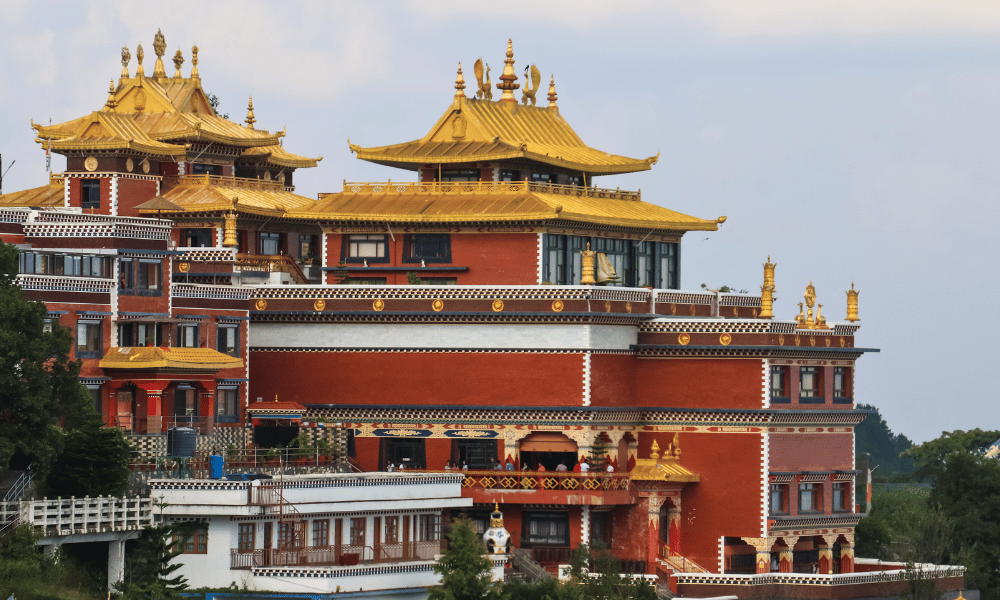
Namobuddha Monastery is a breathtaking escape from the bustling and dreary city life that you simply must experience. The place seems like it's out of a fairy tale with panoramic mountain views and Buddhist stupas atop the hill. It's a place of great merit and spiritual significance for those who visit and offer their respects.
Visitors to Namobuddha monastery can explore the monastery and learn about the rich history and culture of Buddhism in Nepal. The peaceful and serene atmosphere of the monastery is accentuated by its beautiful gardens and courtyards, which are perfect for relaxation and meditation. Furthermore, visitors can revel in the scenic beauty of the surrounding area, which is dotted with rolling hills and lush green forests. On clear days, you can witness the stunning Himalayan panorama of Gaurishankar, Dorje Lakpa, Choba Bhamare, Langtang, Shishapangma, Manaslu, Ganesh Himal, Numbur, Rolwaling, among others. Namo Buddha is considered one of the most sacred pilgrimage sites among the Buddhist people, with the Thrangu Tashi Yangtse Monastery as the main attraction in the village.
On the full moon day in November, a grand festival is held at Namo Buddha monastery, attracting thousands of Buddhist pilgrims from Nepal and beyond. The festival involves prayers and cultural programs and serves as a celebration of the life and teachings of Buddha. The stupa is built in a traditional Tibetan style and is adorned with colorful prayer flags like other Buddhist monasteries in Nepal. Inside, there is a small shrine where devotees offer prayers and offerings.
A popular activity among visitors is the hike to Namo Buddha. During the hike, visitors get to appreciate the stunning landscapes and breathtaking views of the Himalayan mountains. The trail is well-maintained and easy to navigate, with a few steep sections that require a moderate level of fitness. There are also several small restaurants and tea shops where visitors can indulge in a cup of tea or a meal. After visiting Namo Buddha, visitors can either hike back to Dhulikhel or take a short drive back. The hike is suitable for visitors of all ages and is an excellent way to experience the natural beauty and cultural heritage of Nepal.
Overall, Namobuddha monastery is a beautiful and sacred place that provides a unique insight into the spiritual and cultural heritage of Nepal. It is a destination that everyone interested in Buddhism or seeking a peaceful and rejuvenating experience in nature must visit. Now, let's delve deeper into the fascinating facts and information about this spiritual and cultural heritage site in Nepal.
|
Monument |
Namo Buddha Monastery also known as: Thrangu Tashi Yangtse Monastery |
|
Place |
Simalchaur Syampati, Namobuddha Municipality |
|
Province |
Bagmati |
|
Founder |
V.V. Khenchen Thrangu Rinpoche (1978) |
|
Major attractions |
|
|
Entry Fees |
No Entry Fees |
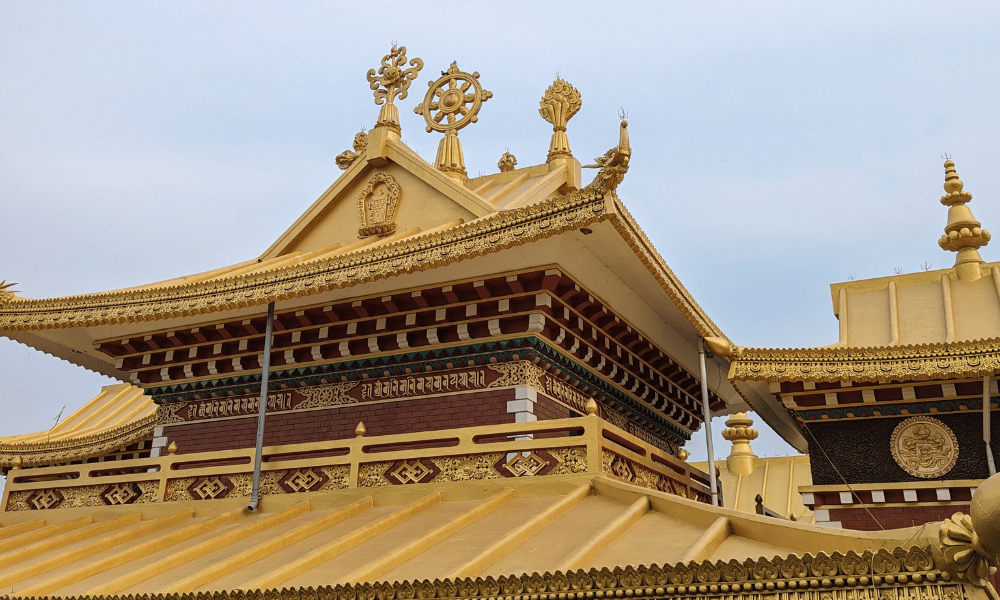
Once upon a time, in a faraway past, the Buddha was a practitioner on the path of learning. The story of Namo Buddha tells us how he showed great compassion when he encountered a starving tigress and selflessly offered his own body to feed her.
In ancient times, a king named Great Charioteer ruled over a small kingdom with five thousand subjects. Thanks to the king's merit, his subjects were happy and prosperous, and nature was abundant. The king had three sons: Great Sound, Great Deity, and Great Being. The eldest two were strong and skilled in martial arts, assisting the king in governing the kingdom, while the youngest son was known for his spontaneous kindness and compassion.
One day, the royal family and their ministers went on a trip to the countryside. After setting up camp and enjoying a lavish feast, the three princes went for a walk in the forest, where they stumbled upon a tigress and her cubs. While the two elder brothers prepared to kill the tigress, Great Being was moved with compassion when he saw that she was unable to move or hunt for food due to starvation and protecting her cubs.
Great Being asked his brothers how they could help the tigress, and they explained that fresh flesh and blood were needed. However, the Great Being did not want to kill another living being to save her. He decided to sacrifice himself, thinking that his body could feed the tigress and save her and her cubs.
Great Being went back to the tigress's den and offered his body to her by cutting it with a sharpened splinter and letting her lick his blood. The tigress, strengthened by the offering, devoured him. When Great Sound and Great Deity came to look for their brother, they found nothing but bits of clothing, blood, nails, and bones. They were overcome with grief and sadness and returned to the encampment to inform their parents.
In conclusion, the story of Namo Buddha depicts Buddha's compassion, sacrifice, and selflessness. It teaches us the importance of showing kindness and compassion to all beings, regardless of their species, and to be willing to sacrifice ourselves for the greater good.

Namo Buddha(Thrangu Tashi Yangtse Monastery) a sacred pilgrimage site located about forty kilometers from Boudhanath Stupa, is a tranquil and serene destination situated on a slightly elevated terrain. The panoramic view from this place resembles an eight-petaled lotus, while the sky above resembles a wheel with nine spokes. The landscape is adorned with mountains that gleam white like a conch shell or a crystal, and groves of trees that sparkle like emerald and turquoise jewels.
The cool southern winds in summer and warm gentle sun in winter make this place an ideal destination for meditation. The blooming multicolored flowers and the beautiful clouds that gather in the sky at daybreak further enhance the ambiance of the place. It is said that all the harmonious conditions required for practicing samadhi are present at this site, inspiring faith and naturally arising renunciation and weariness with samsara.
The area is called Namo Buddha because, after the Great Being offered his body in generosity to a tigress, people were afraid of all wild animals in the region and began reciting "Namo Buddhaya" to dispel their anxiety. Villages gradually appeared, and cultivated fields extended from the houses over time, and the ancient stupa became a sacred site for accumulating merit through circumambulation and offerings. People from all over the world come to visit the stupa and make traditional offerings of butter lamps, fresh coats of white paint, and pleated cloths that encircle the base of its spire.
The town of Panauti, about eight kilometers below the stupa, has ruins that are believed to be the palace of the King Great Charioteer. On the fifteenth day of the fourth Tibetan month, people from the region gather to perform ceremonies and set out a gilded bronze statue of the Buddha. A small temple about three kilometers below the stupa is believed to contain the remains of the Prince Great Being's mother and an image of her is carved into stone inside. A little spring in the woods below the stupa gives blessed water, and the place where the prince offered his body in great generosity can be visited after a fifteen-minute walk up from the stupa.
Two caves in the locale are venerated, one near the monastery and another on a nearby hill. Many great individuals, including scholars and meditation masters from different traditions, have visited Namo Buddha over the centuries. These include Vasubandhu, Jowo Je, Atisha, Situ Chökyi Jungne, Bero Lotsawa Tsewang Kunkhyab, the XVIth Gyalwang Karmapa, Rigpe Dorje, Drugchen Khyabgon Rinpoche, Drikung Khyabgon Rinpoche, Khyabje Dudjom Rinpoche, Dilgo Khyentse Rinpoche, Drubwang Pema Norbu, Chatral Rinpoche, Khenchen Jigme Phuntsok, and Khewang Gendun Chöphel, among others.
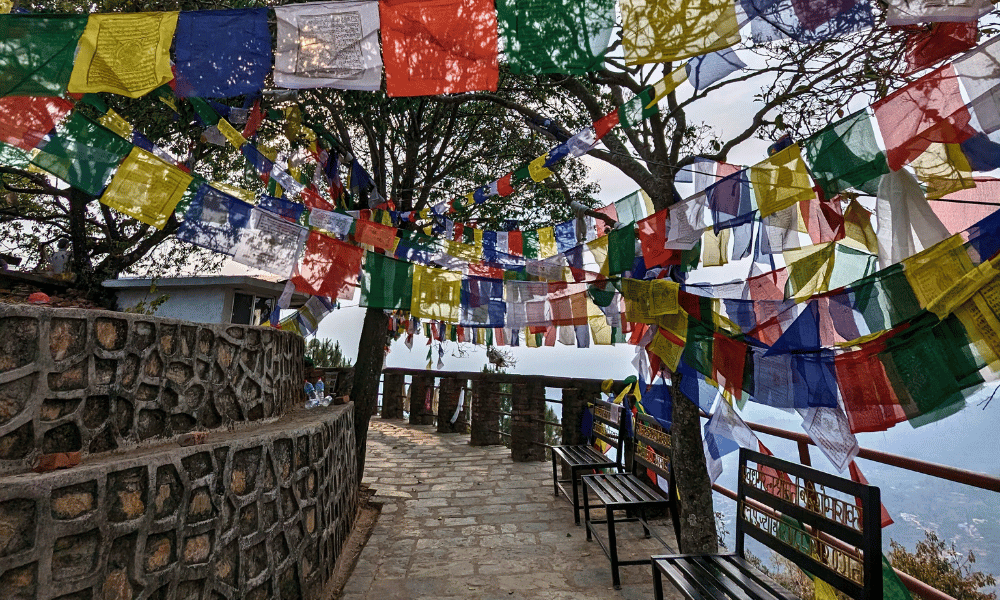
Visitors of all backgrounds can be found trekking to Namo Buddha to capture memories and find solace amongst the holy site's stupas and prayer flags. Devout Buddhists pay their respects to the Buddha and make offerings, particularly inside the cave where the Buddha reportedly sacrificed himself to tigers. Regardless of one's reason for visiting, Namo Buddha welcomes all with open arms. It is important, however, to take one's time and appreciate the intricate details that make Namo Buddha unique, rather than rushing through the temple grounds.
This event is one of the biggest and most crowded events that takes place in the Namo Buddha area in April or May. Similarly, in Panauti area, the “Aja Aji” festival is observed every year during the month of August with the belief that every year on this day Prince Mahasatto visits his home Panauti with Aja and Aji who is believed to be his father and mother.It is a time of great importance for both the local community and Buddhist pilgrims who come from all over the world to participate.
During the festival, people gather at the ancient stupa and monastery to pay homage to Lord Buddha and perform traditional Buddhist rituals. They offer butter lamps and other offerings, recite mantras and prayers, and engage in meditation and other spiritual practices. Monks and nuns from various Buddhist traditions come to Namo Buddha to participate in the festival and give teachings and blessings to the attendees.
The Namo Buddha Jatara is also a time of joy and celebration, with traditional music, dance, and feasting. The local Newar community performs its unique cultural dances and musical performances, and visitors can enjoy local Nepali food and drinks.
The festival has a long history in the region, dating back to ancient times when people came to the site to pay homage to Lord Buddha and seek his blessings. It has continued to evolve and grow over the centuries, and today it is an important event that brings together people from all walks of life to celebrate and honor the teachings of Lord Buddha.
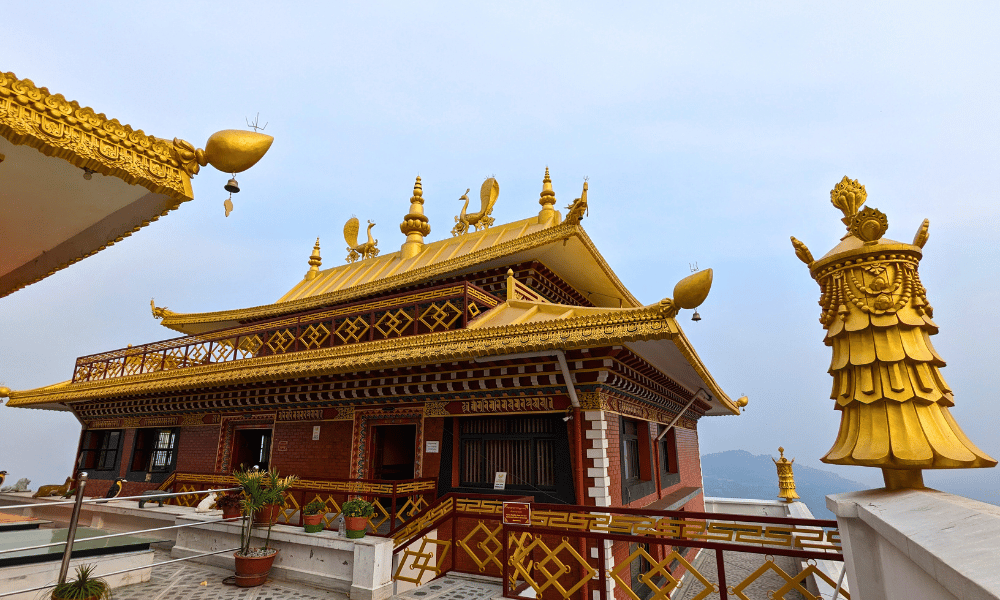
There are many reasons to visit Namo Buddha, but in this article, we'll focus on three major attractions that make it a must-see destination for anyone interested in Buddhism and spiritual practice: the Thrangu Tashi Yangtse Monastery, the Shedra (institute for higher Buddhist studies), the Thrangu Tensheng Tsokpa (organization concerned with the preservation of authentic Himalayan Buddhist art), and the Dewachen Temple. Each of these attractions offers a unique glimpse into the rich spiritual traditions and history of Buddhism.
Khyabje Thrangu Rinpoche dedicated immense effort and perseverance to establish the monastery, recognizing the sanctity of the site and disregarding the challenges. Despite the lack of basic amenities such as roads and water, he was undeterred and drew inspiration from the teachings of the Buddha and the Kagyu tradition. His vision was to create three distinct sections within the monastery: a monastic college focused on Buddhist philosophy, a practice assembly focused on meditation, and an activity contingent focused on the practical aspects of maintaining the monastery.
Thrangu Rinpoche's aim was to benefit the world by promoting peace and nonviolence, and by pacifying misfortune such as sickness, famine, fighting, and quarrels. He hoped that people would be inspired to follow the path of peace, leading to temporary benefits such as rebirth in higher realms and ultimate benefits such as definitive liberation. As the following quote suggests, his aspiration to benefit others was profound and unwavering:
"Noble individuals do not boast of their intentions,
for they do not make promises easily.
Their words are as if inscribed in stone,
unchanging even beyond death."
When Thrangu Rinpoche began establishing these three sections of Dharma activity at the monastery, there were no motorable roads, and he had to make the 12-kilometer journey from Dhulikhel on foot many times. He had no personal quarters, and electricity had not yet been installed. Despite these challenges, he worked tirelessly and selflessly to achieve his vision. As the saying goes: "The Buddha never tires of benefiting living beings."
It is the institute for higher buddhist studies. The Namo Buddha stupa in Nepal is a special place where our supreme teacher Shakyamuni, once took birth as the prince Nyingthob Chenpo and offered his body to a tigress on the verge of starvation. This act of compassion is believed to pacify the problems of degenerate times and bring well-being and goodness to the world. Thrangu Rinpoche began building a monastery there in 1978 to continue the blessings of the teacher and teachings.
To follow the perfect and complete Buddha, one must engage in both aspects of the precious teachings - scriptural study and meditative realization. Institutes for higher studies and places of practice, such as monasteries, are crucial for generating confidence in the teachings and one's ability to realize them. Treatises composed by great panditas from India, such as Nagarjuna and Vasubhandu, are able to bring about certainty in the teachings and are studied alongside commentaries from the Kagyu tradition. The key points of Buddhist view, meditation, and conduct are fully comprehended through this study, ensuring the tradition of being teacher and student does not deteriorate. Engaging in explanation, debate, and composition is a wonderful way to spread the precious teachings and ensure they remain for a long time.
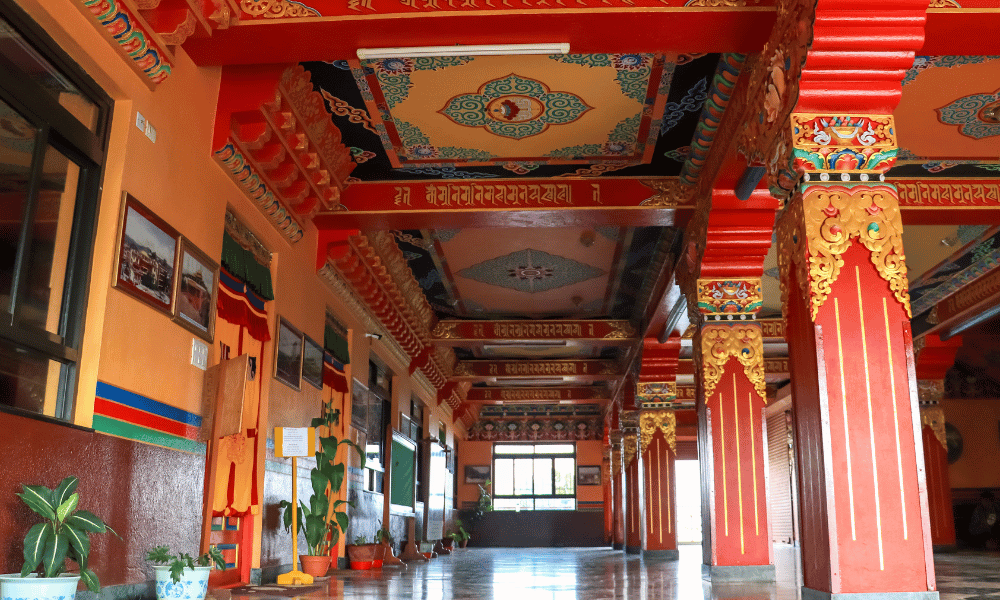
The Thrangu Tensheng Tsokpa is an organization concerned with the preservation of authentic Himalayan Buddhist art. Established in 2008 by Venerable Khenchen Thrangu Rinpoche, its goal is to have all traditional sciences gathered at Namo Buddha. The artists of Thrangu Tensheng Tsokpa are currently painting the lineage figures of the sixteen Karmapas in the main shrine hall of the temple at Namo Buddha using pure stone colors to ensure the paintings last for more than a hundred years. After completing this work, the artists will produce Buddhist thangkas and other artworks to benefit the Sangha and lay students worldwide. The proceeds from the sale of thangkas go toward the organization's operating costs.
Dewachen is a special place where Buddha Amitabha lives. Buddhists believe that it's the most important and easiest place to be born after death. People worship Buddha Amitabha and want to be born in Dewachen. Khenchen Thrangu Rinpoche built the Dewachen Temple at Namo Buddha to represent this special place. Namo Buddha is where the Buddha, in a past life, offered his body to a starving tigress. There is a stupa with his bone relics there, so keeping pictures of the living and deceased in the Dewachen Temple brings blessings. We pray that the deceased will be born in this pure land of ultimate happiness. We do Amitabha and five other aspiration prayers twice a month to help people have a swift rebirth in Dewachen.
The Thrangu Tashi Yangtse Monastery is the lifeblood of Namo Buddha, sustaining the community of hundreds of monks who call the mountainside their home. Many of these young monks are from Tamang families, an ethnic group with deep roots in both Tibet and Buddhism. To provide their children with better education and the chance to attain enlightenment, parents send them to the monastery. On weekends, the air is filled with the sounds of joyful reunions as families embrace their little red-robed prodigies.
But life as a novice monk is no cakewalk. Between English, Nepali, and math classes, the children have to commit countless prayers and rites to memory just to keep up with their studies. Even on Saturdays, when most kids are free to play, the young monks can be seen outside their dorms, swaying gently back and forth as they recite their mantras with unshakeable devotion.
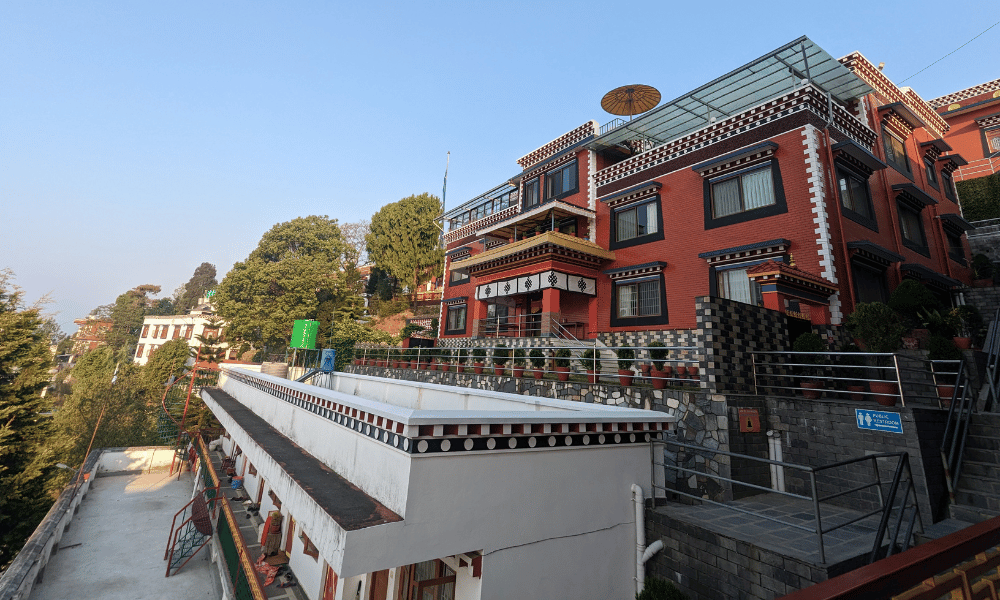
The best time to visit Namo Buddha depends on your preferences and travel plans.
The region has a temperate climate, with relatively mild temperatures throughout the year, so you can visit any time of the year. However, the most popular times to visit are during the spring (March to May) and autumn (September to November) seasons. During these times, the weather is usually mild and pleasant, with clear skies, making it perfect for sightseeing and outdoor activities.
If you prefer a quieter and less crowded time to visit, then the monsoon season (June to August) and winter (December to February) can be good options. During the monsoon season, the area becomes lush and green with plenty of waterfalls, and in winter, you can enjoy clear views of the Himalayan Mountains.
Keep in mind that the Namo Buddha Jatra festival takes place in April or May, so if you plan to attend the festival, that would be the best time to visit.
There are two main roads that will take you to Namo Buddha Monastery. One can travel through Dhulikhel or from Panauti. Both journeys are worth the time.
By Bus:
For those looking for a more adventurous journey to Namo Buddha, you can take a local bus from Ratna Park Bus Station to Banepa. Once you arrive in Banepa, there are two options to reach Namo Buddha. You can either take a bus to Panauti or catch a direct bus to the Namo Buddha area. Ask for the next bus heading to Namo Buddha, which should take approximately 2 hours to reach the final bus stop. From there, it's just a 10-minute walk to reach the monastery. While this option may take longer and involve more transfers, it can offer a unique and immersive experience of local transportation in Nepal.
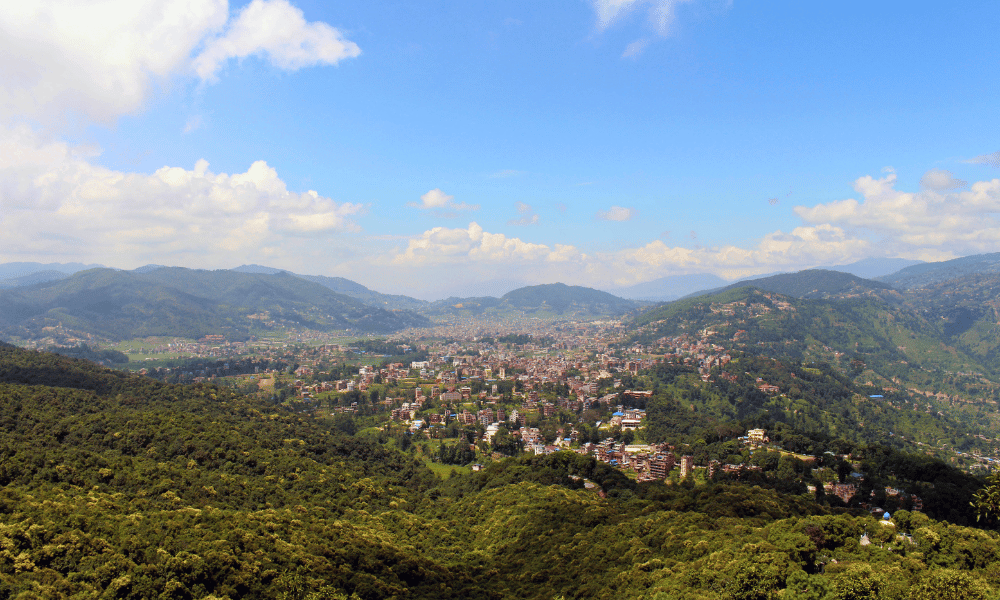
By car:
If you are coming from Kathmandu, make your way towards Bhaktapur and Banepa until you reach Dhulikhel (around 23 km). Take the paved Sindhuli-Highway and continue for 8 km until you reach Kavre Bhanjyang. Turn right onto the Namo Buddha Road and travel for approximately 4.5 km. Once you pass Phulbari village, continue on the same road until you reach the entrance of Namo Buddha, which is just a few kilometers away. From there, it takes about 20 minutes of walking up steep stairs until you reach the first dome of peace and tranquility. Don't hesitate to ask locals for directions if you need help finding your way.
By bike:
For those seeking an adventurous and eco-friendly mode of transportation, bring your own bike or rent one from one of the many bike rental shops in the valley.
Hiking:
To hike to Namo Buddha, there are two main starting points available. The first is in Dhulikhel, which is easily accessible through the Araniko Highway from Kathmandu. This option is suitable for those who prefer a quick route without the need for hiking or exploring the countryside.
Alternatively, if you're seeking a more intimate and relaxed experience, consider turning off the dusty highway and venturing into the historic town of Panauti. With its magnificent views of the mountains, lush hills, and ancient temples, Panauti's small-town charm is sure to captivate you. This route offers a leisurely trek that can be enjoyed at your own pace, making it an ideal choice for those who want to take their time exploring the area.
From Dhulikhel:
Trekking from Dhulikhel to Namo Buddha is a popular activity enjoyed by many, and is suitable for all ages. The duration of the trek, which typically takes around 3 to 5 hours, depends on the individual's fitness level. To reach Namo Buddha from Dhulikhel, start by making your way to Kali Temple via 1000 steps (Hjaar Sidhi, you can ask locals for directions). From there, trek downhill for 20 minutes to Kavre Bhanjyang, a junction. Cross the main road, BP Koirala Highway, and use the trail through the pine forest for 20 minutes until you reach Phaskot village. Follow the road through the village until you reach Chisupani village, where a stupa and school can be seen. Continue on the trail for approximately 20 minutes until you reach the telephone tower in Phulbari village, and from there, follow the trail for another 30 minutes until you arrive at the entrance for Namo Buddha.
From Panauti:
To reach Namo Buddha from Panauti, hikers of all levels can enjoy an easy trek as the distance to the temple is relatively short. On clear days, Namo Buddha can even be spotted from downtown Panauti. The journey typically takes between 2-3 hours one way and there are two main routes available to hikers. For those with limited time or looking to spend most of their day at the monastery, hiking through Shankhu provides a direct route to the temple. Along the way, hikers will pass through charming villages, shops, and fields where locals tend to their crops.

While the hike from Panauti to Namo Buddha provides a glimpse of the area's beauty, it only scratches the surface of what the town of Panauti has to offer. On the other hand, Dhulikhel boasts a romantic landscape of forests, terraces, and mountains.
Exploring a monastery can be a wonderful and fulfilling experience, but it's important to be respectful and mindful of the traditions and practices of the residents. By following these guidelines, you can have an enjoyable and enriching experience that will stay with you for a lifetime:
Plan your visit:
Plan ahead and check the schedule to make sure the monastery is open on the day you want to go. Keep in mind that it may be closed for various ceremonies and festivals.
Respect local customs:
Respect the local customs by not touching or climbing on any monuments and following all required rules. Be attentive to your surroundings.
Follow Rules and regulations:
Learn the rules regarding photography and video-taking, as some places may not allow photographs or videos.
Enjoy your time:
Take some time to experience the natural beauty of the area, try meditation, and check out the panoramic mountain views. Wear sunblock, a hat, or sunglasses to protect yourself from the sun. Also, bring water and snacks to keep you going throughout the day.
Be attentive:
Be quiet and respectful around the monasteries, especially when monks are practicing their mantras and chants. Be aware of your surroundings, especially during festivals and other events when the area can get crowded. Keep an eye on your belongings and be cautious of scams.
Carry Cash:
Carry some cash with you, as some of the smaller vendors and shops near the monastery may not accept credit cards.
The ancient history of Namo Buddha tells the inspiring story of the Buddha's compassion and selflessness when he sacrificed his own body to feed a starving tigress. This story serves as a reminder of the importance of kindness and compassion towards all beings.
Throughout history, Namo Buddha has attracted numerous revered figures, scholars, and meditation masters from different Buddhist traditions. The site welcomes visitors of all backgrounds, providing a space for spiritual connection, contemplation, and appreciation of the intricate details that make Namo Buddha unique.
In summary, Namo Buddha Monastery offers a remarkable blend of natural beauty, spiritual significance, and cultural heritage. It is a destination that promises a rejuvenating escape, a deeper understanding of Buddhism, and a memorable experience amidst breathtaking landscapes. Whether you are seeking tranquility, cultural exploration, or a connection to spirituality, Namo Buddha is an exceptional place that should not be missed.
Namo Buddha Monastery, also known as Thrangu Tashi Yangtse Monastery, is located in Simalchaur Syampati, Namobuddha Municipality, in the Bagmati Province of Nepal.
To reach Namo Buddha from Kathmandu, you can take a scenic drive of approximately 40 kilometers. Alternatively, you can also hire a taxi or join a guided tour that includes transportation to the monastery.
At Namo Buddha, visitors can explore the monastery, admire the beautiful gardens and courtyards, participate in meditation sessions, enjoy the scenic hiking trails, and even witness the grand festival held on the full moon day in November.
No, there are no entry fees to visit Namobuddha Monastery. Visitors are welcome to explore the monastery and its surroundings free of charge.
Yes, Namo Buddha is suitable for visitors of all ages. However, it is important to consider the physical fitness and health conditions of elderly visitors and provide appropriate assistance during the hike to the monastery.
Yes, Namo Buddha offers meditation sessions for those interested in practicing meditation. You can inquire at the monastery for more information and guidance on participating in these sessions.
The best time to visit Namo Buddha is during the spring (March to May) and autumn (September to November) seasons when the weather is pleasant, and the views of the Himalayan mountains are clearer.